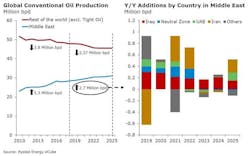Sharp rise in oil production likely across the Middle East
Offshore staff
OSLO, Norway – Middle Eastern oil production is set to rise by 2.7 MMb/d by 2025, according to Rystad Energy.
The increase is primarily due to supply additions from Iraq and an additional 1.2 MMb/d from the Saudi/Kuwaiti Neutral Zone, the UAE, and Iran in the mid-term.
In the UAE, Rystad forecasts that oil production could grow to 3.71 MMb/d in 2025, up from the present 3 MMb/d.
Various expansion projects have been sanctioned that will develop close to 1 Bbbl of oil in 2017-18, with the potential to add 350,000-400,000 b/d in the medium term.
In addition, ADNOC could potentially sanction and bring online further expansion of the Bu Hasa and offshore Umm Shaif fields and the offshore Upper Zakum expansion where production is set to climb by 250,000 b/d to 1 MMb/d.
These developments could add a further 750,000-800,000 b/d to the UAE’s overall output by 2025.
Oil production from the Neutral Zone has been shut since 2015, but earlier this year Saudi Arabia and Kuwait began negotiations concerning a re-start of the fields. Rystad Energy anticipates a gradual ramp up of these fields to roughly 500,000 b/d in the medium term.
Following the re-imposition of US financial sanctions, the analyst expects Iran’s oil output to dip y/y by 700,000 b/d in a conservative case (taking into accounting waivers granted for Europe, India, Japan, and South Korea for 180 days).
Should sanctions continue and then be lifted in 2021, lack of investment during this period would slow the subsequent ramp-up in production, in which case the producing fields would be able to re-start at 90% of the pre-sanction levels.
Ongoing developments, primarily at South Pars 13, 14 and 22-24 in the Persian Gulf, would add around 50,000 b/d by 2025. And development projects with final investment decisions that had been delayed due to the sanctions, once re-started, could potentially add more than 325,000 b/d.
11/15/2018
